Gender and Development Analysis
VerifiedAdded on 2020/12/24
|13
|3926
|425
Essay
AI Summary
This essay argues that a comprehensive gender and development analysis must acknowledge the various feminist perspectives and their contributions to dismantling oppression in all its forms. It examines key concepts like women's empowerment, the politics of difference, and the impact of cultural norms on gender equality, drawing on case studies from Bangladesh and Kenya to illustrate the complexities of achieving social justice.
Contribute Materials
Your contribution can guide someone’s learning journey. Share your
documents today.
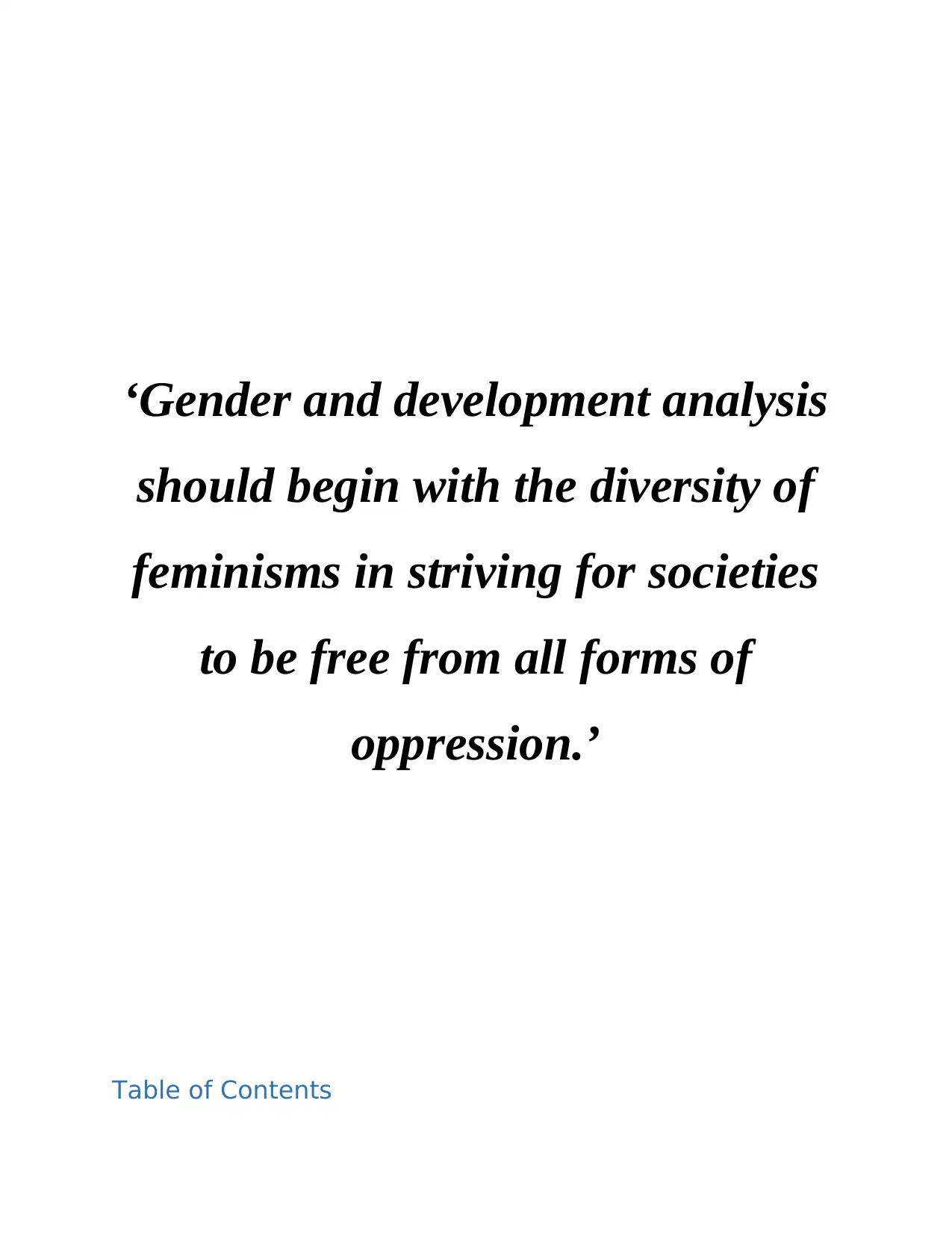
‘Gender and development analysis
should begin with the diversity of
feminisms in striving for societies
to be free from all forms of
oppression.’
Table of Contents
should begin with the diversity of
feminisms in striving for societies
to be free from all forms of
oppression.’
Table of Contents
Secure Best Marks with AI Grader
Need help grading? Try our AI Grader for instant feedback on your assignments.
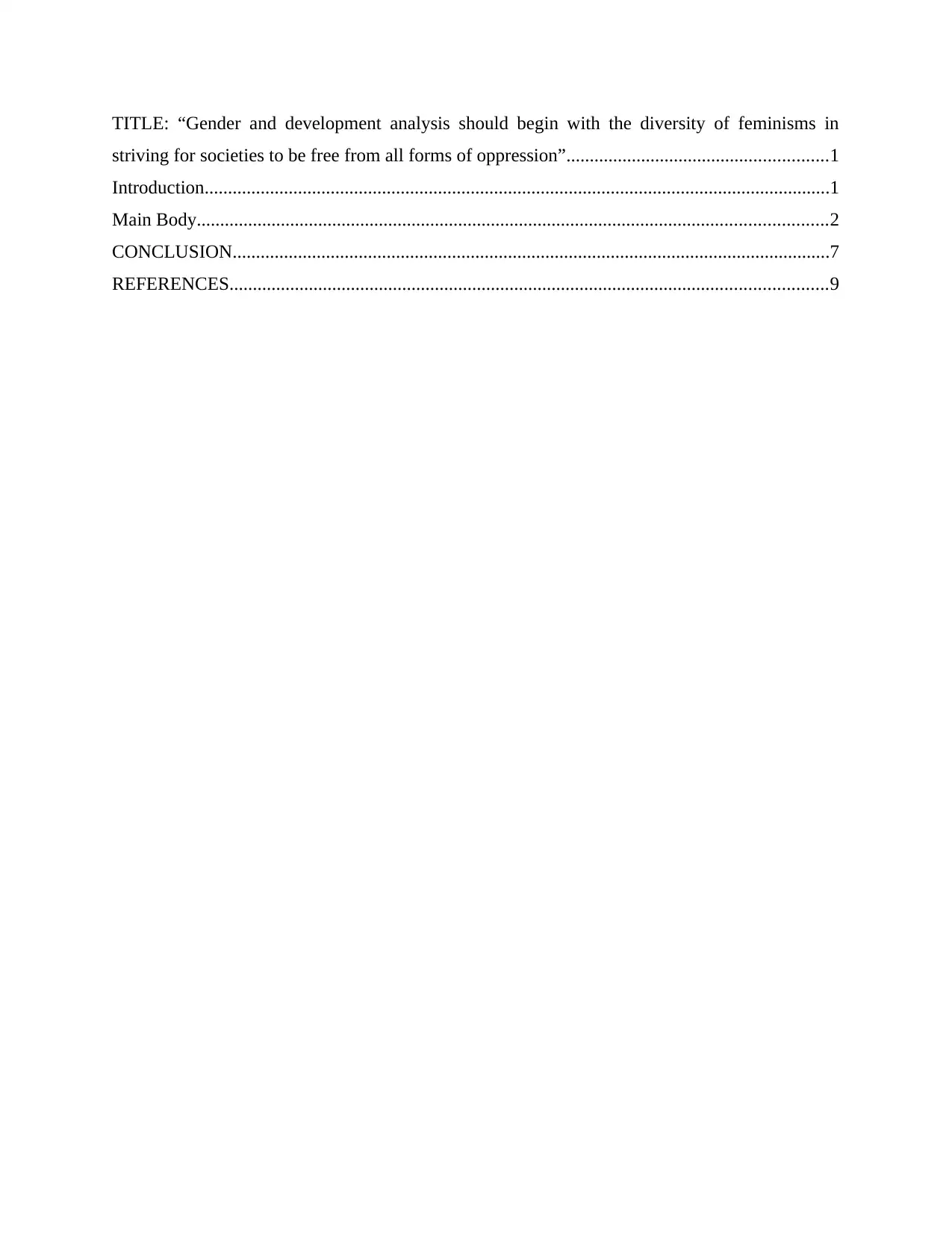
TITLE: “Gender and development analysis should begin with the diversity of feminisms in
striving for societies to be free from all forms of oppression”........................................................1
Introduction......................................................................................................................................1
Main Body.......................................................................................................................................2
CONCLUSION................................................................................................................................7
REFERENCES................................................................................................................................9
striving for societies to be free from all forms of oppression”........................................................1
Introduction......................................................................................................................................1
Main Body.......................................................................................................................................2
CONCLUSION................................................................................................................................7
REFERENCES................................................................................................................................9

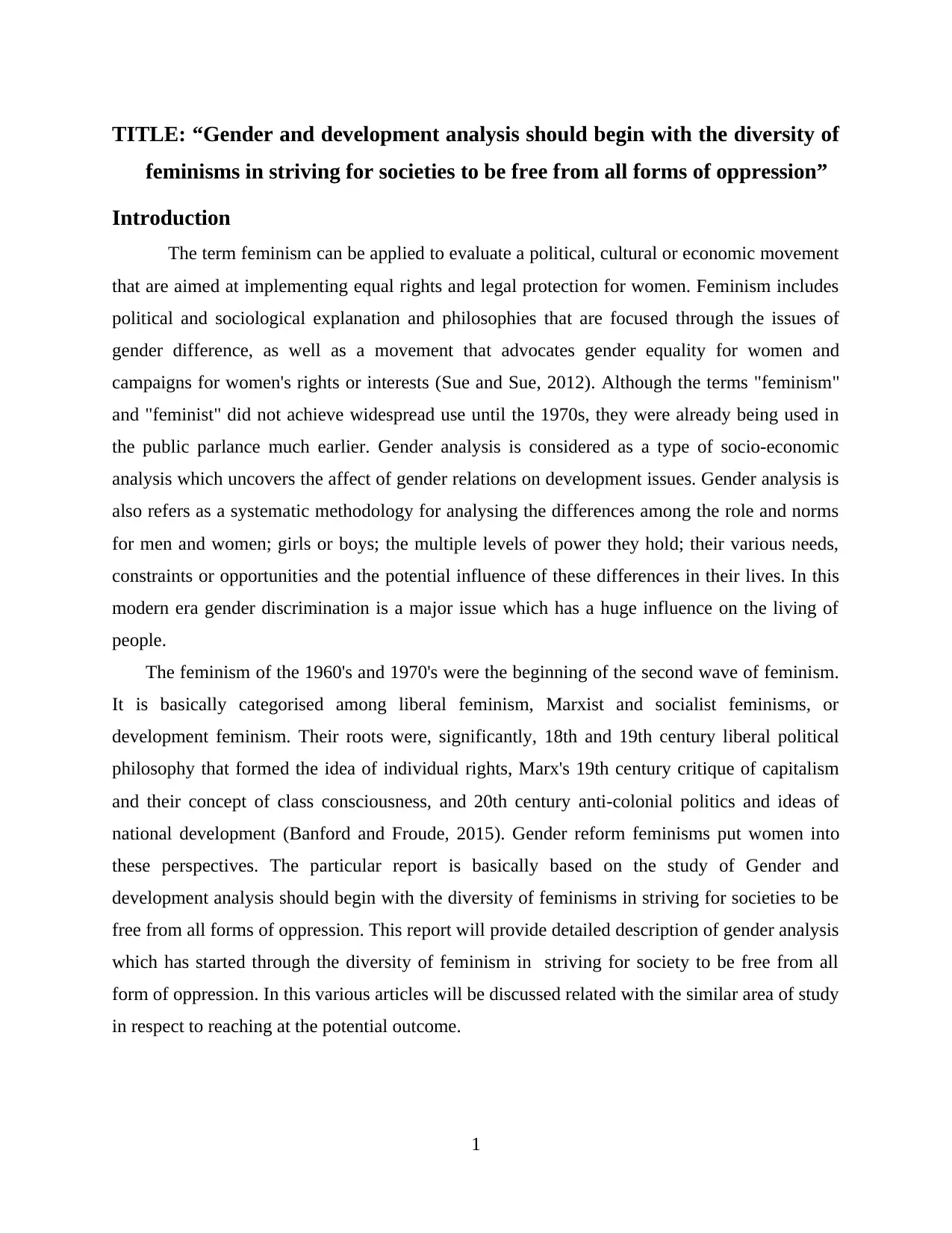
TITLE: “Gender and development analysis should begin with the diversity of
feminisms in striving for societies to be free from all forms of oppression”
Introduction
The term feminism can be applied to evaluate a political, cultural or economic movement
that are aimed at implementing equal rights and legal protection for women. Feminism includes
political and sociological explanation and philosophies that are focused through the issues of
gender difference, as well as a movement that advocates gender equality for women and
campaigns for women's rights or interests (Sue and Sue, 2012). Although the terms "feminism"
and "feminist" did not achieve widespread use until the 1970s, they were already being used in
the public parlance much earlier. Gender analysis is considered as a type of socio-economic
analysis which uncovers the affect of gender relations on development issues. Gender analysis is
also refers as a systematic methodology for analysing the differences among the role and norms
for men and women; girls or boys; the multiple levels of power they hold; their various needs,
constraints or opportunities and the potential influence of these differences in their lives. In this
modern era gender discrimination is a major issue which has a huge influence on the living of
people.
The feminism of the 1960's and 1970's were the beginning of the second wave of feminism.
It is basically categorised among liberal feminism, Marxist and socialist feminisms, or
development feminism. Their roots were, significantly, 18th and 19th century liberal political
philosophy that formed the idea of individual rights, Marx's 19th century critique of capitalism
and their concept of class consciousness, and 20th century anti-colonial politics and ideas of
national development (Banford and Froude, 2015). Gender reform feminisms put women into
these perspectives. The particular report is basically based on the study of Gender and
development analysis should begin with the diversity of feminisms in striving for societies to be
free from all forms of oppression. This report will provide detailed description of gender analysis
which has started through the diversity of feminism in striving for society to be free from all
form of oppression. In this various articles will be discussed related with the similar area of study
in respect to reaching at the potential outcome.
1
feminisms in striving for societies to be free from all forms of oppression”
Introduction
The term feminism can be applied to evaluate a political, cultural or economic movement
that are aimed at implementing equal rights and legal protection for women. Feminism includes
political and sociological explanation and philosophies that are focused through the issues of
gender difference, as well as a movement that advocates gender equality for women and
campaigns for women's rights or interests (Sue and Sue, 2012). Although the terms "feminism"
and "feminist" did not achieve widespread use until the 1970s, they were already being used in
the public parlance much earlier. Gender analysis is considered as a type of socio-economic
analysis which uncovers the affect of gender relations on development issues. Gender analysis is
also refers as a systematic methodology for analysing the differences among the role and norms
for men and women; girls or boys; the multiple levels of power they hold; their various needs,
constraints or opportunities and the potential influence of these differences in their lives. In this
modern era gender discrimination is a major issue which has a huge influence on the living of
people.
The feminism of the 1960's and 1970's were the beginning of the second wave of feminism.
It is basically categorised among liberal feminism, Marxist and socialist feminisms, or
development feminism. Their roots were, significantly, 18th and 19th century liberal political
philosophy that formed the idea of individual rights, Marx's 19th century critique of capitalism
and their concept of class consciousness, and 20th century anti-colonial politics and ideas of
national development (Banford and Froude, 2015). Gender reform feminisms put women into
these perspectives. The particular report is basically based on the study of Gender and
development analysis should begin with the diversity of feminisms in striving for societies to be
free from all forms of oppression. This report will provide detailed description of gender analysis
which has started through the diversity of feminism in striving for society to be free from all
form of oppression. In this various articles will be discussed related with the similar area of study
in respect to reaching at the potential outcome.
1
Secure Best Marks with AI Grader
Need help grading? Try our AI Grader for instant feedback on your assignments.
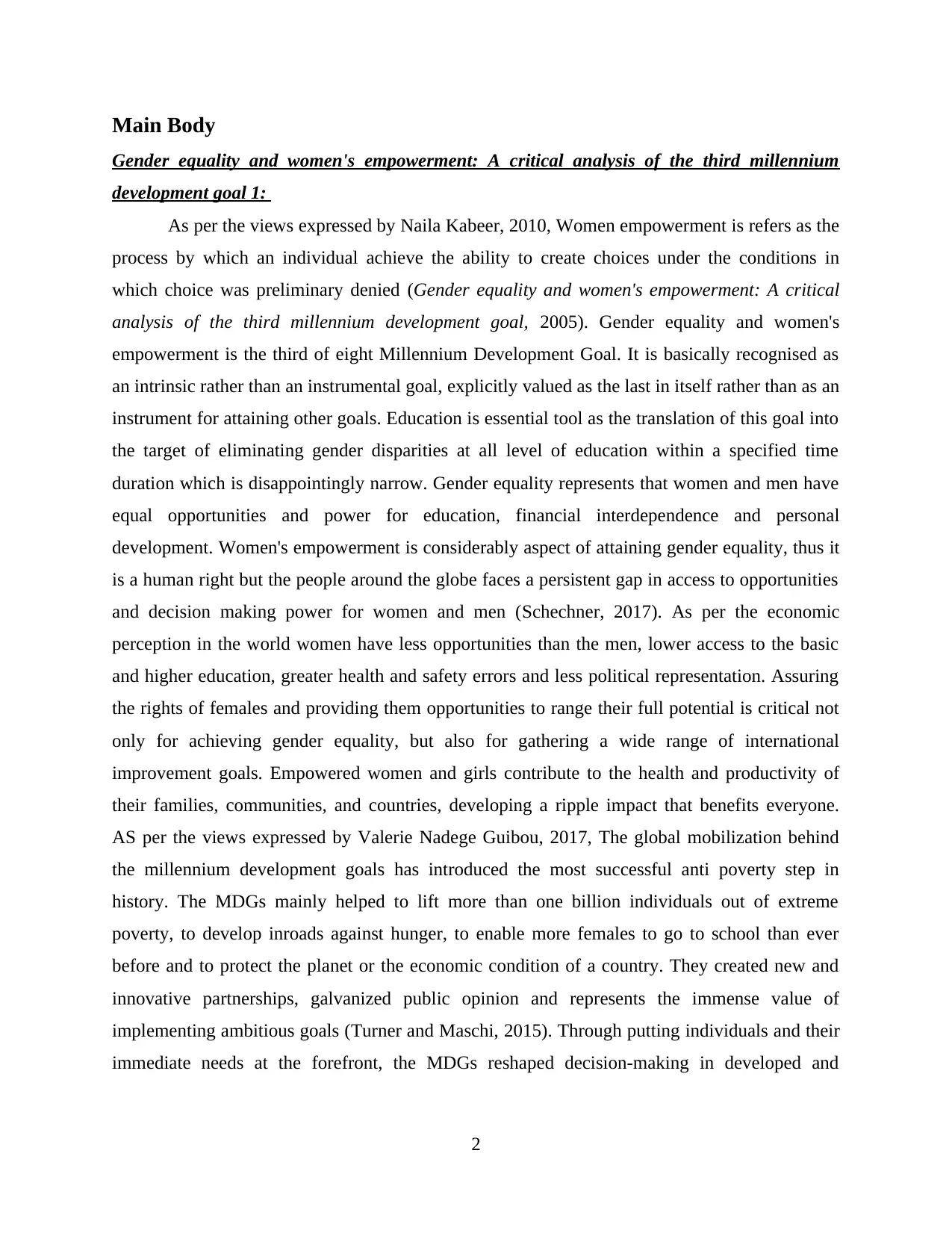
Main Body
Gender equality and women's empowerment: A critical analysis of the third millennium
development goal 1:
As per the views expressed by Naila Kabeer, 2010, Women empowerment is refers as the
process by which an individual achieve the ability to create choices under the conditions in
which choice was preliminary denied (Gender equality and women's empowerment: A critical
analysis of the third millennium development goal, 2005). Gender equality and women's
empowerment is the third of eight Millennium Development Goal. It is basically recognised as
an intrinsic rather than an instrumental goal, explicitly valued as the last in itself rather than as an
instrument for attaining other goals. Education is essential tool as the translation of this goal into
the target of eliminating gender disparities at all level of education within a specified time
duration which is disappointingly narrow. Gender equality represents that women and men have
equal opportunities and power for education, financial interdependence and personal
development. Women's empowerment is considerably aspect of attaining gender equality, thus it
is a human right but the people around the globe faces a persistent gap in access to opportunities
and decision making power for women and men (Schechner, 2017). As per the economic
perception in the world women have less opportunities than the men, lower access to the basic
and higher education, greater health and safety errors and less political representation. Assuring
the rights of females and providing them opportunities to range their full potential is critical not
only for achieving gender equality, but also for gathering a wide range of international
improvement goals. Empowered women and girls contribute to the health and productivity of
their families, communities, and countries, developing a ripple impact that benefits everyone.
AS per the views expressed by Valerie Nadege Guibou, 2017, The global mobilization behind
the millennium development goals has introduced the most successful anti poverty step in
history. The MDGs mainly helped to lift more than one billion individuals out of extreme
poverty, to develop inroads against hunger, to enable more females to go to school than ever
before and to protect the planet or the economic condition of a country. They created new and
innovative partnerships, galvanized public opinion and represents the immense value of
implementing ambitious goals (Turner and Maschi, 2015). Through putting individuals and their
immediate needs at the forefront, the MDGs reshaped decision-making in developed and
2
Gender equality and women's empowerment: A critical analysis of the third millennium
development goal 1:
As per the views expressed by Naila Kabeer, 2010, Women empowerment is refers as the
process by which an individual achieve the ability to create choices under the conditions in
which choice was preliminary denied (Gender equality and women's empowerment: A critical
analysis of the third millennium development goal, 2005). Gender equality and women's
empowerment is the third of eight Millennium Development Goal. It is basically recognised as
an intrinsic rather than an instrumental goal, explicitly valued as the last in itself rather than as an
instrument for attaining other goals. Education is essential tool as the translation of this goal into
the target of eliminating gender disparities at all level of education within a specified time
duration which is disappointingly narrow. Gender equality represents that women and men have
equal opportunities and power for education, financial interdependence and personal
development. Women's empowerment is considerably aspect of attaining gender equality, thus it
is a human right but the people around the globe faces a persistent gap in access to opportunities
and decision making power for women and men (Schechner, 2017). As per the economic
perception in the world women have less opportunities than the men, lower access to the basic
and higher education, greater health and safety errors and less political representation. Assuring
the rights of females and providing them opportunities to range their full potential is critical not
only for achieving gender equality, but also for gathering a wide range of international
improvement goals. Empowered women and girls contribute to the health and productivity of
their families, communities, and countries, developing a ripple impact that benefits everyone.
AS per the views expressed by Valerie Nadege Guibou, 2017, The global mobilization behind
the millennium development goals has introduced the most successful anti poverty step in
history. The MDGs mainly helped to lift more than one billion individuals out of extreme
poverty, to develop inroads against hunger, to enable more females to go to school than ever
before and to protect the planet or the economic condition of a country. They created new and
innovative partnerships, galvanized public opinion and represents the immense value of
implementing ambitious goals (Turner and Maschi, 2015). Through putting individuals and their
immediate needs at the forefront, the MDGs reshaped decision-making in developed and
2

developing countries alike. Yet for all the remarkable increase, inequalities persist and that
progress has been uneven in nature.
Feminist Perspectives on Power
As per the opinion of Amy Allen, 2016, Feminism is basically seems an undeniable
aspect that much work in feminist theory is dedicated to the tasks of critiquing Female
subordination, analysing the crossways between sexism and other forms of subordination
likewise racism, heterosexism, and class oppression, and picturing the expectation for both
individual and collective resistance to subordination (Feminist Perspectives on Power, 2005).
However the concept of power is mainly central to each of these theoretical evaluation and
basically power is concisely a central aspect fir feminist theory as well. thus, curiously, power is
one which is not often explicitly analysed in feminist work. In the conceptualisation of social and
political theory, power is often regarded as an important aspect. Although this claim is itself
contested that there is no doubt that the literature on power is marked through deep, seemingly or
widespread intractable disagreement over how the term power should be well analysed or
understood. The constitutional conception of power, through contrast, centring on the
fundamentally trans-individual and relational structure in which people and the social worlds
they inhabit are themselves constituted through the power relations. The roots of this constituent
conception can be derived back to Spinous (Turner and Maschi, 2015). The conception of power
is considered as a source that can be found in the work of some liberal feminists. For instance, in
Justice of Gender, and the Family, Susan Moller Okin argues that the contemporary gender-
structured family unjustly distributes the welfare and burdens of familial life amongst husbands
and wives. Okin involves power on her list of advantages, so that she calls “critical social
goods.” As she puts it, “when we look gravely at the dispersion among husbands and wives of
such critical social goods as work that are paid and unpaid in nature, power, prestige, self-
esteem, opportunities for self-development, and both physical and economic security, we find
socially constructed inequalities among them (Schechner, 2017). Here, Okin appear to imply that
power is a assets that is evenly and unjustly apportioned among men and women; hence, one of
the goals of feminism would be to redistribute this resource in more equitable manner.
Feminism and Revolution: Looking back, Looking Ahead.
3
progress has been uneven in nature.
Feminist Perspectives on Power
As per the opinion of Amy Allen, 2016, Feminism is basically seems an undeniable
aspect that much work in feminist theory is dedicated to the tasks of critiquing Female
subordination, analysing the crossways between sexism and other forms of subordination
likewise racism, heterosexism, and class oppression, and picturing the expectation for both
individual and collective resistance to subordination (Feminist Perspectives on Power, 2005).
However the concept of power is mainly central to each of these theoretical evaluation and
basically power is concisely a central aspect fir feminist theory as well. thus, curiously, power is
one which is not often explicitly analysed in feminist work. In the conceptualisation of social and
political theory, power is often regarded as an important aspect. Although this claim is itself
contested that there is no doubt that the literature on power is marked through deep, seemingly or
widespread intractable disagreement over how the term power should be well analysed or
understood. The constitutional conception of power, through contrast, centring on the
fundamentally trans-individual and relational structure in which people and the social worlds
they inhabit are themselves constituted through the power relations. The roots of this constituent
conception can be derived back to Spinous (Turner and Maschi, 2015). The conception of power
is considered as a source that can be found in the work of some liberal feminists. For instance, in
Justice of Gender, and the Family, Susan Moller Okin argues that the contemporary gender-
structured family unjustly distributes the welfare and burdens of familial life amongst husbands
and wives. Okin involves power on her list of advantages, so that she calls “critical social
goods.” As she puts it, “when we look gravely at the dispersion among husbands and wives of
such critical social goods as work that are paid and unpaid in nature, power, prestige, self-
esteem, opportunities for self-development, and both physical and economic security, we find
socially constructed inequalities among them (Schechner, 2017). Here, Okin appear to imply that
power is a assets that is evenly and unjustly apportioned among men and women; hence, one of
the goals of feminism would be to redistribute this resource in more equitable manner.
Feminism and Revolution: Looking back, Looking Ahead.
3

According to the opinion of Julie Matthaei, 2018, At the time of striving of second wave,
feminism a half century ago, the concept and movement has increasingly more systematic and
inclusive in nature. The post-feminist states that the liberation of actual women's needs
transcending both patriarchy or capitalism and however a politics at once feminist and ant-
classist was important (Feminism and Revolution: Looking back, Looking Ahead, 2006) . At very
earlier, they, too, were challenged to widen their explanation and practice to admit oppressions
originate through race, nationality, sexual position, and other resources of identity and social
location. Overcoming this situations, gave beginning to a commonality politics among feminism
rooted in intersectionality and manifest both within the movement and in its relationship with
other movements. Significantly, this new politics offers paths for people to take participation in
radical social change now through developing unique practices and institutions in the solidarity
economy (Renzetti, 2016). An inexorable and inclusive feminism remains important for
developing the wide solidarity politics and economics an individual requires for a Great
Transition which eliminates oppression of all kinds.
Feminism and the Politics of Difference
According to the opinion of Maria O'Reilly, 2012, One of the most recent concern of
feminist theory and practice is the politics of differentiation in culture. Feminism is the aim that
women should have the rights and power which the men have. Women should have the same
rights, that is, Political, Social, and Economical that the men have. In today's modern era, the
politics of cultural difference, division, diversity or differentiation has emerged as one of the
most contentions concern of feminist theory (Feminism and the Politics of Difference 2012). The
feminist practitioners have greatly challenged and sought to address gendered forms of
inequality, subordination or oppression in the variety of political, economic and social context.
However, feminists have been entangled in deep theoretical disagreements over an assortment of
issues, involving the nature and significance of the relationship among culture and the production
of gendered social life, as well as the issues in regards to location for women’s agency, feminist
knowledge production, and the expectation of building cross-cultural feminist coalitions and
agendas (Banford and Froude, 2015). Some of the approaches which executed in the “first” and
“second waves” of feminist scholarship and activism were not able to effectively engage with
questions of culture.
Is Diversity the Answer to Gender Equality
4
feminism a half century ago, the concept and movement has increasingly more systematic and
inclusive in nature. The post-feminist states that the liberation of actual women's needs
transcending both patriarchy or capitalism and however a politics at once feminist and ant-
classist was important (Feminism and Revolution: Looking back, Looking Ahead, 2006) . At very
earlier, they, too, were challenged to widen their explanation and practice to admit oppressions
originate through race, nationality, sexual position, and other resources of identity and social
location. Overcoming this situations, gave beginning to a commonality politics among feminism
rooted in intersectionality and manifest both within the movement and in its relationship with
other movements. Significantly, this new politics offers paths for people to take participation in
radical social change now through developing unique practices and institutions in the solidarity
economy (Renzetti, 2016). An inexorable and inclusive feminism remains important for
developing the wide solidarity politics and economics an individual requires for a Great
Transition which eliminates oppression of all kinds.
Feminism and the Politics of Difference
According to the opinion of Maria O'Reilly, 2012, One of the most recent concern of
feminist theory and practice is the politics of differentiation in culture. Feminism is the aim that
women should have the rights and power which the men have. Women should have the same
rights, that is, Political, Social, and Economical that the men have. In today's modern era, the
politics of cultural difference, division, diversity or differentiation has emerged as one of the
most contentions concern of feminist theory (Feminism and the Politics of Difference 2012). The
feminist practitioners have greatly challenged and sought to address gendered forms of
inequality, subordination or oppression in the variety of political, economic and social context.
However, feminists have been entangled in deep theoretical disagreements over an assortment of
issues, involving the nature and significance of the relationship among culture and the production
of gendered social life, as well as the issues in regards to location for women’s agency, feminist
knowledge production, and the expectation of building cross-cultural feminist coalitions and
agendas (Banford and Froude, 2015). Some of the approaches which executed in the “first” and
“second waves” of feminist scholarship and activism were not able to effectively engage with
questions of culture.
Is Diversity the Answer to Gender Equality
4
Paraphrase This Document
Need a fresh take? Get an instant paraphrase of this document with our AI Paraphraser
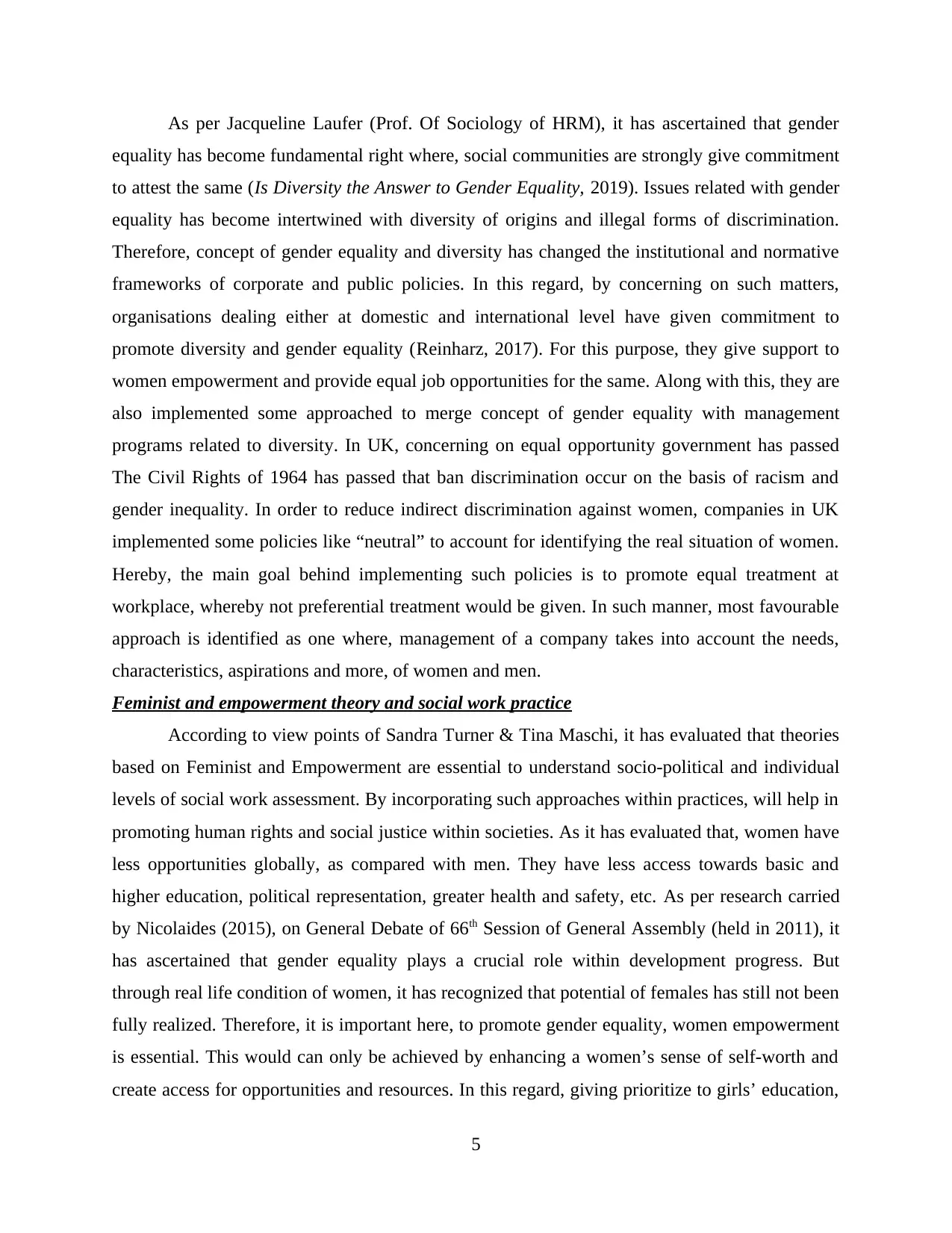
As per Jacqueline Laufer (Prof. Of Sociology of HRM), it has ascertained that gender
equality has become fundamental right where, social communities are strongly give commitment
to attest the same (Is Diversity the Answer to Gender Equality, 2019). Issues related with gender
equality has become intertwined with diversity of origins and illegal forms of discrimination.
Therefore, concept of gender equality and diversity has changed the institutional and normative
frameworks of corporate and public policies. In this regard, by concerning on such matters,
organisations dealing either at domestic and international level have given commitment to
promote diversity and gender equality (Reinharz, 2017). For this purpose, they give support to
women empowerment and provide equal job opportunities for the same. Along with this, they are
also implemented some approached to merge concept of gender equality with management
programs related to diversity. In UK, concerning on equal opportunity government has passed
The Civil Rights of 1964 has passed that ban discrimination occur on the basis of racism and
gender inequality. In order to reduce indirect discrimination against women, companies in UK
implemented some policies like “neutral” to account for identifying the real situation of women.
Hereby, the main goal behind implementing such policies is to promote equal treatment at
workplace, whereby not preferential treatment would be given. In such manner, most favourable
approach is identified as one where, management of a company takes into account the needs,
characteristics, aspirations and more, of women and men.
Feminist and empowerment theory and social work practice
According to view points of Sandra Turner & Tina Maschi, it has evaluated that theories
based on Feminist and Empowerment are essential to understand socio-political and individual
levels of social work assessment. By incorporating such approaches within practices, will help in
promoting human rights and social justice within societies. As it has evaluated that, women have
less opportunities globally, as compared with men. They have less access towards basic and
higher education, political representation, greater health and safety, etc. As per research carried
by Nicolaides (2015), on General Debate of 66th Session of General Assembly (held in 2011), it
has ascertained that gender equality plays a crucial role within development progress. But
through real life condition of women, it has recognized that potential of females has still not been
fully realized. Therefore, it is important here, to promote gender equality, women empowerment
is essential. This would can only be achieved by enhancing a women’s sense of self-worth and
create access for opportunities and resources. In this regard, giving prioritize to girls’ education,
5
equality has become fundamental right where, social communities are strongly give commitment
to attest the same (Is Diversity the Answer to Gender Equality, 2019). Issues related with gender
equality has become intertwined with diversity of origins and illegal forms of discrimination.
Therefore, concept of gender equality and diversity has changed the institutional and normative
frameworks of corporate and public policies. In this regard, by concerning on such matters,
organisations dealing either at domestic and international level have given commitment to
promote diversity and gender equality (Reinharz, 2017). For this purpose, they give support to
women empowerment and provide equal job opportunities for the same. Along with this, they are
also implemented some approached to merge concept of gender equality with management
programs related to diversity. In UK, concerning on equal opportunity government has passed
The Civil Rights of 1964 has passed that ban discrimination occur on the basis of racism and
gender inequality. In order to reduce indirect discrimination against women, companies in UK
implemented some policies like “neutral” to account for identifying the real situation of women.
Hereby, the main goal behind implementing such policies is to promote equal treatment at
workplace, whereby not preferential treatment would be given. In such manner, most favourable
approach is identified as one where, management of a company takes into account the needs,
characteristics, aspirations and more, of women and men.
Feminist and empowerment theory and social work practice
According to view points of Sandra Turner & Tina Maschi, it has evaluated that theories
based on Feminist and Empowerment are essential to understand socio-political and individual
levels of social work assessment. By incorporating such approaches within practices, will help in
promoting human rights and social justice within societies. As it has evaluated that, women have
less opportunities globally, as compared with men. They have less access towards basic and
higher education, political representation, greater health and safety, etc. As per research carried
by Nicolaides (2015), on General Debate of 66th Session of General Assembly (held in 2011), it
has ascertained that gender equality plays a crucial role within development progress. But
through real life condition of women, it has recognized that potential of females has still not been
fully realized. Therefore, it is important here, to promote gender equality, women empowerment
is essential. This would can only be achieved by enhancing a women’s sense of self-worth and
create access for opportunities and resources. In this regard, giving prioritize to girls’ education,
5
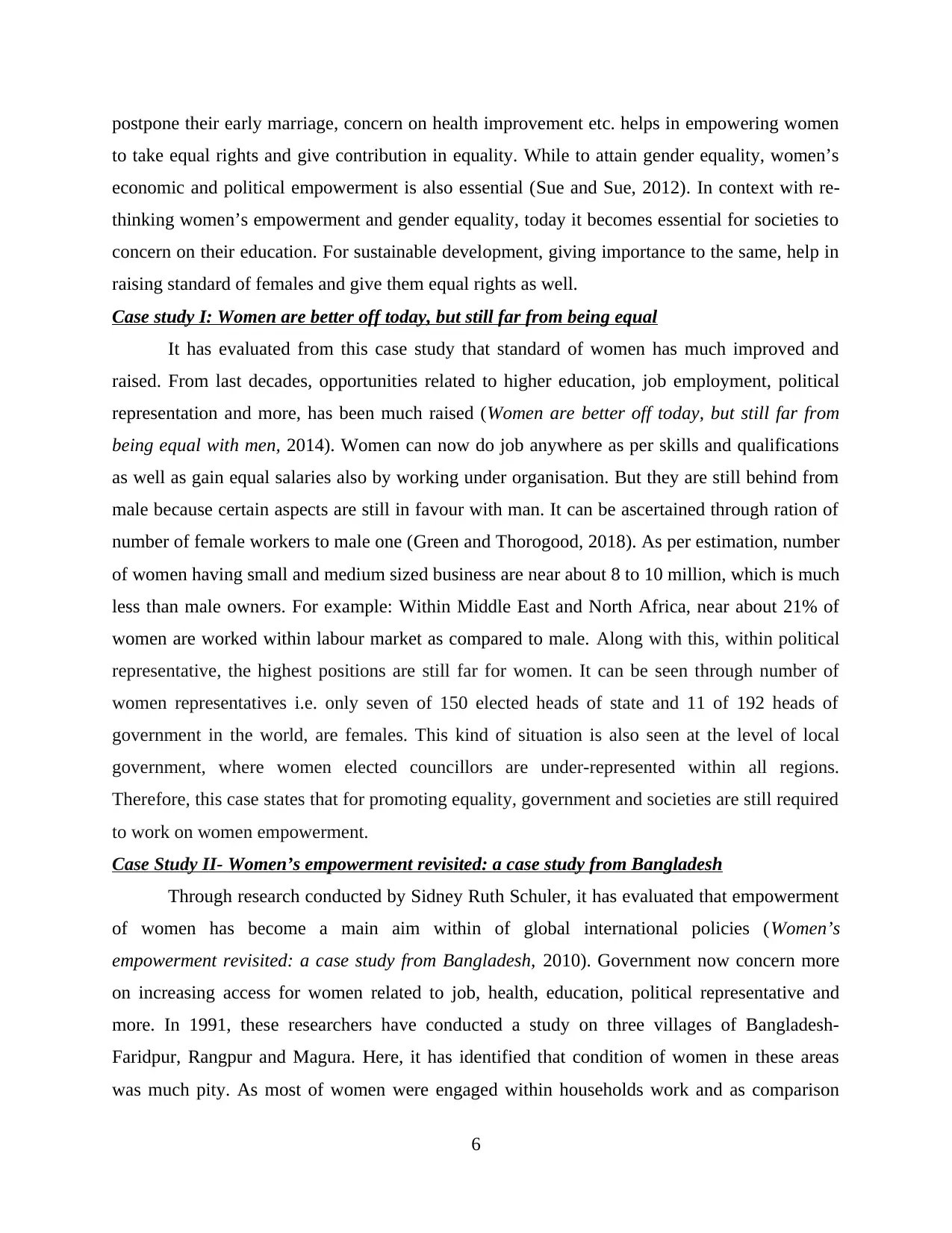
postpone their early marriage, concern on health improvement etc. helps in empowering women
to take equal rights and give contribution in equality. While to attain gender equality, women’s
economic and political empowerment is also essential (Sue and Sue, 2012). In context with re-
thinking women’s empowerment and gender equality, today it becomes essential for societies to
concern on their education. For sustainable development, giving importance to the same, help in
raising standard of females and give them equal rights as well.
Case study I: Women are better off today, but still far from being equal
It has evaluated from this case study that standard of women has much improved and
raised. From last decades, opportunities related to higher education, job employment, political
representation and more, has been much raised (Women are better off today, but still far from
being equal with men, 2014). Women can now do job anywhere as per skills and qualifications
as well as gain equal salaries also by working under organisation. But they are still behind from
male because certain aspects are still in favour with man. It can be ascertained through ration of
number of female workers to male one (Green and Thorogood, 2018). As per estimation, number
of women having small and medium sized business are near about 8 to 10 million, which is much
less than male owners. For example: Within Middle East and North Africa, near about 21% of
women are worked within labour market as compared to male. Along with this, within political
representative, the highest positions are still far for women. It can be seen through number of
women representatives i.e. only seven of 150 elected heads of state and 11 of 192 heads of
government in the world, are females. This kind of situation is also seen at the level of local
government, where women elected councillors are under-represented within all regions.
Therefore, this case states that for promoting equality, government and societies are still required
to work on women empowerment.
Case Study II- Women’s empowerment revisited: a case study from Bangladesh
Through research conducted by Sidney Ruth Schuler, it has evaluated that empowerment
of women has become a main aim within of global international policies (Women’s
empowerment revisited: a case study from Bangladesh, 2010). Government now concern more
on increasing access for women related to job, health, education, political representative and
more. In 1991, these researchers have conducted a study on three villages of Bangladesh-
Faridpur, Rangpur and Magura. Here, it has identified that condition of women in these areas
was much pity. As most of women were engaged within households work and as comparison
6
to take equal rights and give contribution in equality. While to attain gender equality, women’s
economic and political empowerment is also essential (Sue and Sue, 2012). In context with re-
thinking women’s empowerment and gender equality, today it becomes essential for societies to
concern on their education. For sustainable development, giving importance to the same, help in
raising standard of females and give them equal rights as well.
Case study I: Women are better off today, but still far from being equal
It has evaluated from this case study that standard of women has much improved and
raised. From last decades, opportunities related to higher education, job employment, political
representation and more, has been much raised (Women are better off today, but still far from
being equal with men, 2014). Women can now do job anywhere as per skills and qualifications
as well as gain equal salaries also by working under organisation. But they are still behind from
male because certain aspects are still in favour with man. It can be ascertained through ration of
number of female workers to male one (Green and Thorogood, 2018). As per estimation, number
of women having small and medium sized business are near about 8 to 10 million, which is much
less than male owners. For example: Within Middle East and North Africa, near about 21% of
women are worked within labour market as compared to male. Along with this, within political
representative, the highest positions are still far for women. It can be seen through number of
women representatives i.e. only seven of 150 elected heads of state and 11 of 192 heads of
government in the world, are females. This kind of situation is also seen at the level of local
government, where women elected councillors are under-represented within all regions.
Therefore, this case states that for promoting equality, government and societies are still required
to work on women empowerment.
Case Study II- Women’s empowerment revisited: a case study from Bangladesh
Through research conducted by Sidney Ruth Schuler, it has evaluated that empowerment
of women has become a main aim within of global international policies (Women’s
empowerment revisited: a case study from Bangladesh, 2010). Government now concern more
on increasing access for women related to job, health, education, political representative and
more. In 1991, these researchers have conducted a study on three villages of Bangladesh-
Faridpur, Rangpur and Magura. Here, it has identified that condition of women in these areas
was much pity. As most of women were engaged within households work and as comparison
6
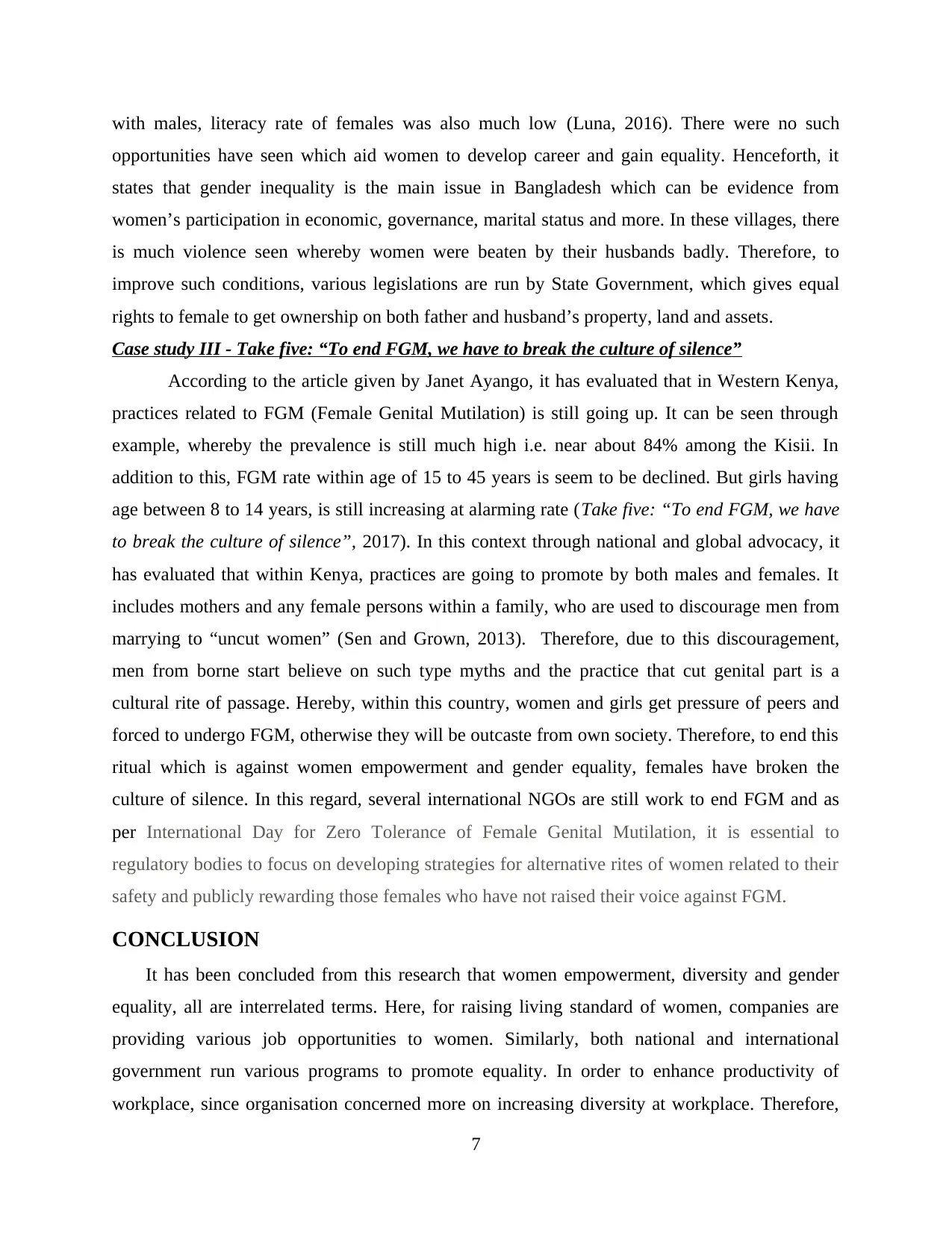
with males, literacy rate of females was also much low (Luna, 2016). There were no such
opportunities have seen which aid women to develop career and gain equality. Henceforth, it
states that gender inequality is the main issue in Bangladesh which can be evidence from
women’s participation in economic, governance, marital status and more. In these villages, there
is much violence seen whereby women were beaten by their husbands badly. Therefore, to
improve such conditions, various legislations are run by State Government, which gives equal
rights to female to get ownership on both father and husband’s property, land and assets.
Case study III - Take five: “To end FGM, we have to break the culture of silence”
According to the article given by Janet Ayango, it has evaluated that in Western Kenya,
practices related to FGM (Female Genital Mutilation) is still going up. It can be seen through
example, whereby the prevalence is still much high i.e. near about 84% among the Kisii. In
addition to this, FGM rate within age of 15 to 45 years is seem to be declined. But girls having
age between 8 to 14 years, is still increasing at alarming rate (Take five: “To end FGM, we have
to break the culture of silence”, 2017). In this context through national and global advocacy, it
has evaluated that within Kenya, practices are going to promote by both males and females. It
includes mothers and any female persons within a family, who are used to discourage men from
marrying to “uncut women” (Sen and Grown, 2013). Therefore, due to this discouragement,
men from borne start believe on such type myths and the practice that cut genital part is a
cultural rite of passage. Hereby, within this country, women and girls get pressure of peers and
forced to undergo FGM, otherwise they will be outcaste from own society. Therefore, to end this
ritual which is against women empowerment and gender equality, females have broken the
culture of silence. In this regard, several international NGOs are still work to end FGM and as
per International Day for Zero Tolerance of Female Genital Mutilation, it is essential to
regulatory bodies to focus on developing strategies for alternative rites of women related to their
safety and publicly rewarding those females who have not raised their voice against FGM.
CONCLUSION
It has been concluded from this research that women empowerment, diversity and gender
equality, all are interrelated terms. Here, for raising living standard of women, companies are
providing various job opportunities to women. Similarly, both national and international
government run various programs to promote equality. In order to enhance productivity of
workplace, since organisation concerned more on increasing diversity at workplace. Therefore,
7
opportunities have seen which aid women to develop career and gain equality. Henceforth, it
states that gender inequality is the main issue in Bangladesh which can be evidence from
women’s participation in economic, governance, marital status and more. In these villages, there
is much violence seen whereby women were beaten by their husbands badly. Therefore, to
improve such conditions, various legislations are run by State Government, which gives equal
rights to female to get ownership on both father and husband’s property, land and assets.
Case study III - Take five: “To end FGM, we have to break the culture of silence”
According to the article given by Janet Ayango, it has evaluated that in Western Kenya,
practices related to FGM (Female Genital Mutilation) is still going up. It can be seen through
example, whereby the prevalence is still much high i.e. near about 84% among the Kisii. In
addition to this, FGM rate within age of 15 to 45 years is seem to be declined. But girls having
age between 8 to 14 years, is still increasing at alarming rate (Take five: “To end FGM, we have
to break the culture of silence”, 2017). In this context through national and global advocacy, it
has evaluated that within Kenya, practices are going to promote by both males and females. It
includes mothers and any female persons within a family, who are used to discourage men from
marrying to “uncut women” (Sen and Grown, 2013). Therefore, due to this discouragement,
men from borne start believe on such type myths and the practice that cut genital part is a
cultural rite of passage. Hereby, within this country, women and girls get pressure of peers and
forced to undergo FGM, otherwise they will be outcaste from own society. Therefore, to end this
ritual which is against women empowerment and gender equality, females have broken the
culture of silence. In this regard, several international NGOs are still work to end FGM and as
per International Day for Zero Tolerance of Female Genital Mutilation, it is essential to
regulatory bodies to focus on developing strategies for alternative rites of women related to their
safety and publicly rewarding those females who have not raised their voice against FGM.
CONCLUSION
It has been concluded from this research that women empowerment, diversity and gender
equality, all are interrelated terms. Here, for raising living standard of women, companies are
providing various job opportunities to women. Similarly, both national and international
government run various programs to promote equality. In order to enhance productivity of
workplace, since organisation concerned more on increasing diversity at workplace. Therefore,
7
Secure Best Marks with AI Grader
Need help grading? Try our AI Grader for instant feedback on your assignments.
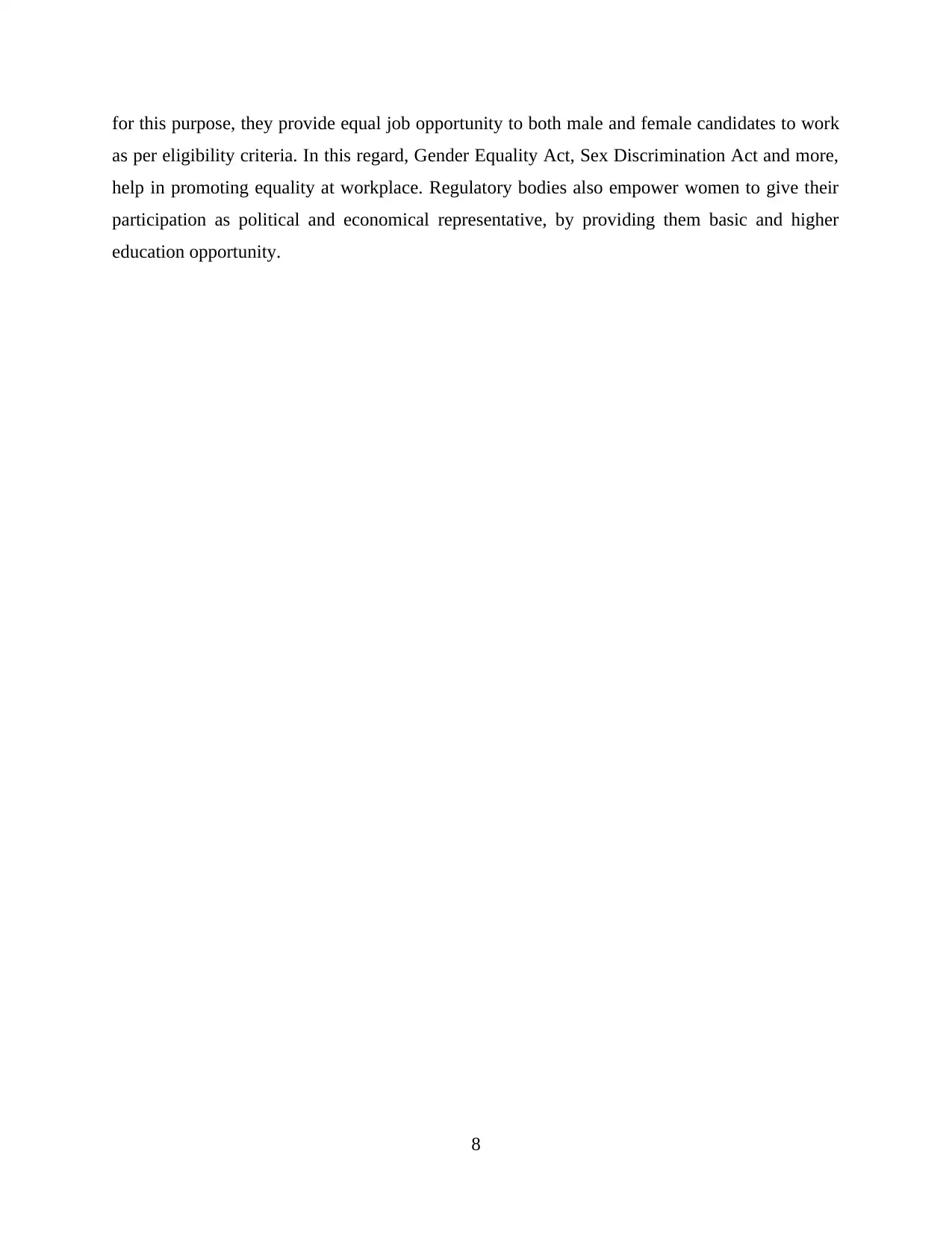
for this purpose, they provide equal job opportunity to both male and female candidates to work
as per eligibility criteria. In this regard, Gender Equality Act, Sex Discrimination Act and more,
help in promoting equality at workplace. Regulatory bodies also empower women to give their
participation as political and economical representative, by providing them basic and higher
education opportunity.
8
as per eligibility criteria. In this regard, Gender Equality Act, Sex Discrimination Act and more,
help in promoting equality at workplace. Regulatory bodies also empower women to give their
participation as political and economical representative, by providing them basic and higher
education opportunity.
8
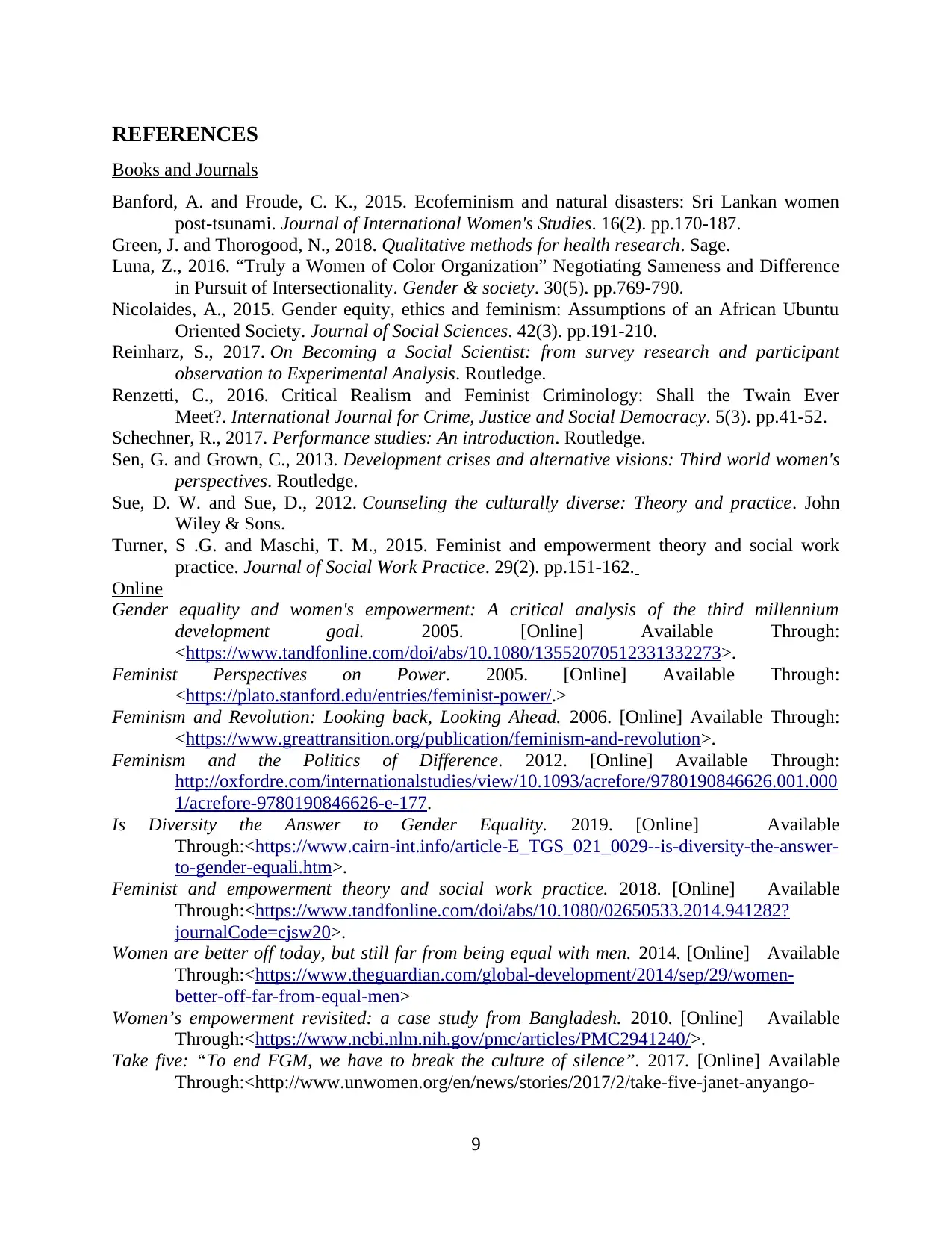
REFERENCES
Books and Journals
Banford, A. and Froude, C. K., 2015. Ecofeminism and natural disasters: Sri Lankan women
post-tsunami. Journal of International Women's Studies. 16(2). pp.170-187.
Green, J. and Thorogood, N., 2018. Qualitative methods for health research. Sage.
Luna, Z., 2016. “Truly a Women of Color Organization” Negotiating Sameness and Difference
in Pursuit of Intersectionality. Gender & society. 30(5). pp.769-790.
Nicolaides, A., 2015. Gender equity, ethics and feminism: Assumptions of an African Ubuntu
Oriented Society. Journal of Social Sciences. 42(3). pp.191-210.
Reinharz, S., 2017. On Becoming a Social Scientist: from survey research and participant
observation to Experimental Analysis. Routledge.
Renzetti, C., 2016. Critical Realism and Feminist Criminology: Shall the Twain Ever
Meet?. International Journal for Crime, Justice and Social Democracy. 5(3). pp.41-52.
Schechner, R., 2017. Performance studies: An introduction. Routledge.
Sen, G. and Grown, C., 2013. Development crises and alternative visions: Third world women's
perspectives. Routledge.
Sue, D. W. and Sue, D., 2012. Counseling the culturally diverse: Theory and practice. John
Wiley & Sons.
Turner, S .G. and Maschi, T. M., 2015. Feminist and empowerment theory and social work
practice. Journal of Social Work Practice. 29(2). pp.151-162.
Online
Gender equality and women's empowerment: A critical analysis of the third millennium
development goal. 2005. [Online] Available Through:
<https://www.tandfonline.com/doi/abs/10.1080/13552070512331332273>.
Feminist Perspectives on Power. 2005. [Online] Available Through:
<https://plato.stanford.edu/entries/feminist-power/.>
Feminism and Revolution: Looking back, Looking Ahead. 2006. [Online] Available Through:
<https://www.greattransition.org/publication/feminism-and-revolution>.
Feminism and the Politics of Difference. 2012. [Online] Available Through:
http://oxfordre.com/internationalstudies/view/10.1093/acrefore/9780190846626.001.000
1/acrefore-9780190846626-e-177.
Is Diversity the Answer to Gender Equality. 2019. [Online] Available
Through:<https://www.cairn-int.info/article-E_TGS_021_0029--is-diversity-the-answer-
to-gender-equali.htm>.
Feminist and empowerment theory and social work practice. 2018. [Online] Available
Through:<https://www.tandfonline.com/doi/abs/10.1080/02650533.2014.941282?
journalCode=cjsw20>.
Women are better off today, but still far from being equal with men. 2014. [Online] Available
Through:<https://www.theguardian.com/global-development/2014/sep/29/women-
better-off-far-from-equal-men>
Women’s empowerment revisited: a case study from Bangladesh. 2010. [Online] Available
Through:<https://www.ncbi.nlm.nih.gov/pmc/articles/PMC2941240/>.
Take five: “To end FGM, we have to break the culture of silence”. 2017. [Online] Available
Through:<http://www.unwomen.org/en/news/stories/2017/2/take-five-janet-anyango-
9
Books and Journals
Banford, A. and Froude, C. K., 2015. Ecofeminism and natural disasters: Sri Lankan women
post-tsunami. Journal of International Women's Studies. 16(2). pp.170-187.
Green, J. and Thorogood, N., 2018. Qualitative methods for health research. Sage.
Luna, Z., 2016. “Truly a Women of Color Organization” Negotiating Sameness and Difference
in Pursuit of Intersectionality. Gender & society. 30(5). pp.769-790.
Nicolaides, A., 2015. Gender equity, ethics and feminism: Assumptions of an African Ubuntu
Oriented Society. Journal of Social Sciences. 42(3). pp.191-210.
Reinharz, S., 2017. On Becoming a Social Scientist: from survey research and participant
observation to Experimental Analysis. Routledge.
Renzetti, C., 2016. Critical Realism and Feminist Criminology: Shall the Twain Ever
Meet?. International Journal for Crime, Justice and Social Democracy. 5(3). pp.41-52.
Schechner, R., 2017. Performance studies: An introduction. Routledge.
Sen, G. and Grown, C., 2013. Development crises and alternative visions: Third world women's
perspectives. Routledge.
Sue, D. W. and Sue, D., 2012. Counseling the culturally diverse: Theory and practice. John
Wiley & Sons.
Turner, S .G. and Maschi, T. M., 2015. Feminist and empowerment theory and social work
practice. Journal of Social Work Practice. 29(2). pp.151-162.
Online
Gender equality and women's empowerment: A critical analysis of the third millennium
development goal. 2005. [Online] Available Through:
<https://www.tandfonline.com/doi/abs/10.1080/13552070512331332273>.
Feminist Perspectives on Power. 2005. [Online] Available Through:
<https://plato.stanford.edu/entries/feminist-power/.>
Feminism and Revolution: Looking back, Looking Ahead. 2006. [Online] Available Through:
<https://www.greattransition.org/publication/feminism-and-revolution>.
Feminism and the Politics of Difference. 2012. [Online] Available Through:
http://oxfordre.com/internationalstudies/view/10.1093/acrefore/9780190846626.001.000
1/acrefore-9780190846626-e-177.
Is Diversity the Answer to Gender Equality. 2019. [Online] Available
Through:<https://www.cairn-int.info/article-E_TGS_021_0029--is-diversity-the-answer-
to-gender-equali.htm>.
Feminist and empowerment theory and social work practice. 2018. [Online] Available
Through:<https://www.tandfonline.com/doi/abs/10.1080/02650533.2014.941282?
journalCode=cjsw20>.
Women are better off today, but still far from being equal with men. 2014. [Online] Available
Through:<https://www.theguardian.com/global-development/2014/sep/29/women-
better-off-far-from-equal-men>
Women’s empowerment revisited: a case study from Bangladesh. 2010. [Online] Available
Through:<https://www.ncbi.nlm.nih.gov/pmc/articles/PMC2941240/>.
Take five: “To end FGM, we have to break the culture of silence”. 2017. [Online] Available
Through:<http://www.unwomen.org/en/news/stories/2017/2/take-five-janet-anyango-
9

fgm>.
10
10
1 out of 13
Related Documents
Your All-in-One AI-Powered Toolkit for Academic Success.
+13062052269
info@desklib.com
Available 24*7 on WhatsApp / Email
![[object Object]](/_next/static/media/star-bottom.7253800d.svg)
Unlock your academic potential
© 2024 | Zucol Services PVT LTD | All rights reserved.





